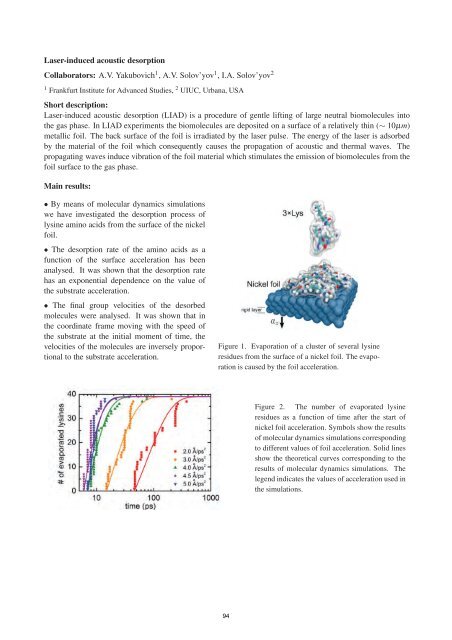FIAS Scientific Report 2011 - Frankfurt Institute for Advanced Studies ...
FIAS Scientific Report 2011 - Frankfurt Institute for Advanced Studies ...
FIAS Scientific Report 2011 - Frankfurt Institute for Advanced Studies ...
You also want an ePaper? Increase the reach of your titles
YUMPU automatically turns print PDFs into web optimized ePapers that Google loves.
Laser-induced acoustic desorption<br />
Collaborators: A.V. Yakubovich 1 , A.V. Solov’yov 1 , I.A. Solov’yov 2<br />
1 <strong>Frankfurt</strong> <strong>Institute</strong> <strong>for</strong> <strong>Advanced</strong> <strong>Studies</strong>, 2 UIUC, Urbana, USA<br />
Short description:<br />
Laser-induced acoustic desorption (LIAD) is a procedure of gentle lifting of large neutral biomolecules into<br />
the gas phase. In LIAD experiments the biomolecules are deposited on a surface of a relatively thin (∼ 10µm)<br />
metallic foil. The back surface of the foil is irradiated by the laser pulse. The energy of the laser is adsorbed<br />
by the material of the foil which consequently causes the propagation of acoustic and thermal waves. The<br />
propagating waves induce vibration of the foil material which stimulates the emission of biomolecules from the<br />
foil surface to the gas phase.<br />
Main results:<br />
• By means of molecular dynamics simulations<br />
we have investigated the desorption process of<br />
lysine amino acids from the surface of the nickel<br />
foil.<br />
• The desorption rate of the amino acids as a<br />
function of the surface acceleration has been<br />
analysed. It was shown that the desorption rate<br />
has an exponential dependence on the value of<br />
the substrate acceleration.<br />
• The final group velocities of the desorbed<br />
molecules were analysed. It was shown that in<br />
the coordinate frame moving with the speed of<br />
the substrate at the initial moment of time, the<br />
velocities of the molecules are inversely proportional<br />
to the substrate acceleration.<br />
Figure 1. Evaporation of a cluster of several lysine<br />
residues from the surface of a nickel foil. The evaporation<br />
is caused by the foil acceleration.<br />
94<br />
Figure 2. The number of evaporated lysine<br />
residues as a function of time after the start of<br />
nickel foil acceleration. Symbols show the results<br />
of molecular dynamics simulations corresponding<br />
to different values of foil acceleration. Solid lines<br />
show the theoretical curves corresponding to the<br />
results of molecular dynamics simulations. The<br />
legend indicates the values of acceleration used in<br />
the simulations.
















